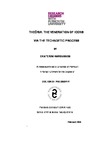THEŌRIA: THE VENERATION OF ICONS VIA THE TECHNOETIC PROCESS
| dc.contributor.supervisor | Ascott, Roy | |
| dc.contributor.author | Karoussos, Ekaterini | |
| dc.contributor.other | Faculty of Arts, Humanities and Business | en_US |
| dc.date.accessioned | 2016-12-05T16:01:34Z | |
| dc.date.available | 2016-12-05T16:01:34Z | |
| dc.date.issued | 2016 | |
| dc.identifier | 10291649 | en_US |
| dc.identifier.uri | http://hdl.handle.net/10026.1/8069 | |
| dc.description.abstract |
The Second Council of Nicaea, in 787 AD, marked the end of iconoclasm, while in 843 the Treaty of Verdun laid the foundations of Europe. With these agreements, a sustained period of imageless iconolatry was initiated. However, the veneration of icons was based on the absolute worship of matter and form, which replaced the prime spiritual concept of ‘image and likeness’. Millennia of research and thought resulted in imageless representations of natural phenomena. Pushing aside the topology of the image and its sign, the intelligent man, from the Age of Reason and onward, considered himself as an auto-authorised and teleological-free entity. To this end, he maximised the intelligibility of his space by designing an all-inclusive Cartesian cocoon in which to secure his mass and form. Yet, there he found his pet (Schrodinger’s Cat) to be both dead and alive, and the apple, still forbidden, had become a bouncing ball, serving as evidence of gravity. Hence, this intelligent design, by default, carries the residual fear of Manichaean and Augustinian devils, and is deemed to have converted to a de-sign crisis. Relying on literature sources, this dissertation examines two dominant models that govern human cognition and the production of knowledge. Despite remarkable scientific achievements which resulted, the aftermath of human progress was, among others, the maximisation of residual fear, to such an extent that voracious black holes devour all matter. Inaugurating the transhumanist period, the human becomes a Manchurian Candidate, still an upgraded ape and a victim of his own nature in the Anthropocene. In an attempt to overcome this de-sign crisis, the research presented in this thesis aims to address the necessity of the restoration of icons, as evidenced by Byzantine art and philosophy but neglected in the name of human supremacy and imperialism. This thesis elucidates Classical and Late Antiquity manuscripts in an effort to set a new ‘restore point’, endeavouring to launch the image in the current organosilicon substances; examples from Scripture narratives as well as from visual arts contribute to this effort. The proposed concluding scheme is the Module of Theōria, which reflects the major transhumanistic elements such as transmutation, interaction and fluidity. Theōria functions through noetic mechanisms, using ‘image and likeness’ as the prime carriers of knowledge. The anticipated outcome is to reveal a human investment in a pro-nature incorruptibility with the advent of Theōria in the field of Τechnoetics, where one can administer ‘image and likeness’ to gain capital liquidity. | en_US |
| dc.language.iso | en | |
| dc.publisher | University of Plymouth | |
| dc.rights | Attribution-NonCommercial-NoDerivs 3.0 United States | * |
| dc.rights.uri | http://creativecommons.org/licenses/by-nc-nd/3.0/us/ | * |
| dc.subject | Byzantine Art | en_US |
| dc.subject | Art | |
| dc.subject | Theoria | |
| dc.subject | Transhumanism | |
| dc.subject | Transmutation | |
| dc.subject | Economy | |
| dc.subject | Nature | |
| dc.subject.classification | PhD | en_US |
| dc.title | THEŌRIA: THE VENERATION OF ICONS VIA THE TECHNOETIC PROCESS | en_US |
| dc.type | Thesis | |
| plymouth.version | publishable | en_US |
| dc.identifier.doi | http://dx.doi.org/10.24382/490 | |
| dc.rights.embargoperiod | No embargo | en_US |
| dc.type.qualification | Doctorate | en_US |
| rioxxterms.funder | Not available | en_US |
| rioxxterms.identifier.project | Not available | en_US |
| rioxxterms.version | NA |
Files in this item
This item appears in the following Collection(s)
-
01 Research Theses Main Collection
Research Theses Main



